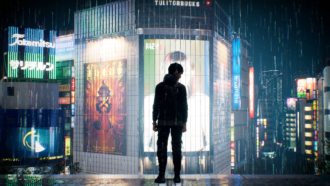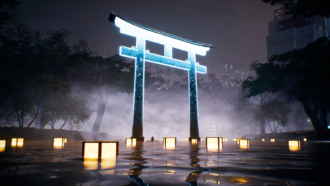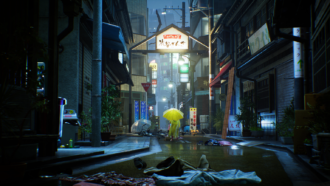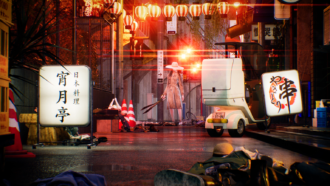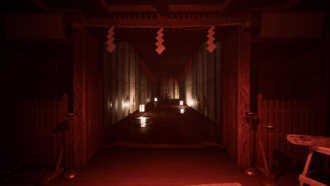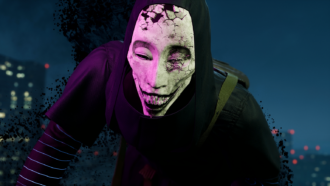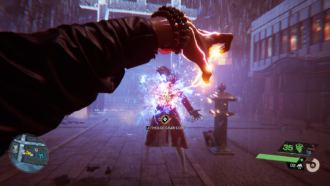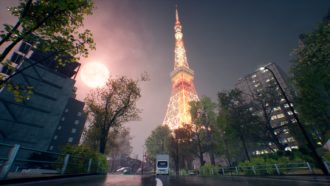Platforms:
PC, PS5
Released:
March 25, 2022
Publisher:
Bethesda Softworks
Developer:
Tango Gameworks
There’s no doubt that the team at Tango Gameworks are incredibly capable when it comes to crafting horrific, narrative-driven worlds to be absorbed in. The Evil Within was a deep dive into a gory, psychological horror and its sequel went even further down this rabbit hole, tapping into some incredibly scary territory, including one particular town that pushed the series out of its linear style and played with the concept of an open world, to great effect. Taking on a new IP this time, Ghostwire: Tokyo goes full open world, with a deserted, well-realised Shibuya making for a fun playground of spirits both friendly and angry, with a bunch of ghostly powers at your fingertips. It makes for a spooky and captivating adventure, even if it can’t fully escape from the open-world trappings that have preceded it.
So uhh… where did everyone go?
In Shibuya, everybody has disappeared, and spirits now roam the streets. You play as Akito, who after a car accident has his body inhabited by a cocky spirit hunter called KK, bringing you back from the brink of death and providing you with powers that allow you to access the spirit world. The two begin in conflict with one another, as Akito quite clearly and rationally doesn’t feel great about sharing his body with its new inhabitant. Still, with Akito searching for his sister and KK searching for answers and closure on what the hell has happened in Tokyo, the goals of their stories intersect, and like any good buddy pairing, they eventually come to see eye-to-eye, as Akito begins to embrace his new powers to save the city.
I found both characters relatively likable, but not particularly memorable either. There are some other key characters you’ll encounter along the way that add some more depth to KK, which means that his grizzly demeanor gets softened somewhat, but Akito doesn’t get much more personality beyond “guy trying to save his sister”, no matter how many creepy flashbacks imply something deeper going on with him. You also won’t spend a whole lot of time with main antagonist Hannya, despite his lingering presence throughout. He seems evil, and I guess that’s enough, but some more context about his dark turn would have been appreciated. Still, the story does enough to keep you invested over the its relatively modest 15-20 hour runtime, and the ending seemed fitting in what is by no means a “survival horror” game, rather an action adventure that is filled with spooks and psychological tricks.
Shibuya itself makes for a fantastic setting that is great to galivant about in, especially for me as a lover of all-things Japan and someone who has visited Shibuya in person before. Considering its now-empty state, it’s haunting and creepy to navigate the backstreets, while even the Shibuya crosswalk is now devoid of life entirely. The city still has electricity though, so billboards still light up, neon lights bounce off puddles in the street and music plays from abandoned shop fronts. It’s always nighttime and often raining which adds further to the creepy atmosphere; humans were here just moments ago, but now they’re gone in the blink of an eye.
“…Tango Gameworks delightfully plays with its environment in creepy ways that catch your eye.”
Of course, Ghostwire: Tokyo doesn’t just feature a regular Shibuya. Beyond being empty when it comes to the living, Tango Gameworks delightfully plays with its environment in creepy ways that catch your eye. Odd projections and silhouettes appear in random locations like on the side of a truck, lights flicker incessantly and shutter doors of shopfronts jitter and slam up and down. Objects like cars, bicycles and bins float above street level and glitch out (which can be used for collecting resources), while umbrellas lay motionless on the ground and evil spirits wander. It’s quite a thrilling atmosphere that I enjoyed exploring immensely.
A whole new (open) world?
After a linear opening chapter that teaches you the ropes, Ghostwire: Tokyo starts to check off some cliché open world boxes that will be instantly familiar. You’ll head towards Torii gates, which must be cleansed of the evil nearby; once you do, the surrounding fog will clear, revealing other points of interest on your map like spirits who need help, shops and so on, while also unlocking the gate as a fast travel point. Moving into the fog before you’ve cleared it damages you, so you’ll need to cleanse each of the gates to access the full map, piece by piece. It’s a way of keeping you from accessing areas before you’re supposed to, but the process itself of “discovering” more of the map has been done time and time again.
The main thing that pops up when you open more of the map are requests from friendly spirits who need your assistance to move on into the afterlife. They’re still bound to earth, seeking closure in many forms; these side missions range from quick tasks like exorcising a cheeky spirit from a family home, to defending an area from multiple enemies, or some more in-depth mini-adventures. One of my favourites involved helping a girl who was meant to meet her partner for a date, but he took his own life after visiting a strange, cursed building. Upon exploring said building, it turns out suicides happen frequently there, and only by exploring the haunted halls and dealing with the evil spirits lurking within can you grant the couple the freedom to ascend. It’s not all so serious though – another spirit request has you searching for racoons hidden across the city, by spotting their tails poking out of random objects.
These spirit requests are the most enjoyable diversions from the main narrative, as much like the various side stories in Assassin’s Creed Valhalla, you really won’t know what kind of task you’re going to get until you speak to each of them, so it adds an element of the unknown that made me want to help each and every one of them, never quite knowing what weird and wacky path they would lead me down.
We’ve been down this road before
Not all of the side activities are quite as unique, though. There’s Far Cry-esque temples that have multiple Torii gates to cleanse, littered with enemies roaming through them. You’ll need to clear them out to capture that point. Praying at statues littered about the city increases your spirit points and your health; paying to receive a blessing at an altar helps fill your map with handy icons so you can track the statues easily. Spirit “cubes” that pop up (with friendly spirits captured within) must be defended from multiple waves of enemies, and they pop up all over the place. For every captivating side story there is a couple of mindless tasks that feel more like filler, which can mess with the pacing a bit.
Shopkeepers in Ghostwire: Tokyo are run by yokai (mysterious supernatural entities in Japanese folklore), in the form of floating, talking cats. They allow you to stock up on supplies, but one in each region sets you on a scavenger hunt to find various knick-knacks from Japanese culture, with clues on how to find each. I didn’t feel particularly compelled to seek them all out, but I did make sure to hand over any that I came across in my travels to collect the generous cash reward. To my delight, when I brought one feline a Daruma mask they wanted, they started wearing it straight away, which was of course adorable.
Streets are filled with passive spirits that are just floating about mindlessly, which you have to hold down a button to absorb into a Katashiro, a traditional Japanese paper doll. Once you’ve absorbed them, you have to hand them in via a mystical phone booth that then gives you XP, allowing you to upgrade your abilities. I’m not kidding when I say these floating spirits are everywhere. Some you can just suck up, while others require you to remove afflictions by tracing a line with your hand, via the right control stick. The method of absorbing them, filling up your Katashiro’s (you can buy more) and then handing them in at the various phone booths becomes a little bit arduous, and I wish that the beads you unlock after completing the game which allow you to instantly turn them into XP without handing them in was available sooner.

Smells like mean spirits
Not all of the spirits you’ll encounter in Ghostwire: Tokyo are passive, of course. There are a variety of enemies known as Visitors who wander the streets, and they’ll attack you on sight. Headless schoolgirls will cartwheel and backflip towards you with attacks, Slendermen-like office-workers with umbrellas will tiptoe-creep quickly at you, and a larger variant uses said umbrella as a shield that’s only vulnerable to certain attacks. Other variants like flying ghosts (some with strange masks) shoot a range of projectiles, and one Visitor type channels her best Lady Dimitrescu, using big scissors as her weapon of choice as she lunges desperately towards you. Small child spirits in yellow raincoats will scream once they see you, spawning multiple enemies to attack you. Early on there isn’t a lot of variety, but as you progress and encounter new foes, they then appear more frequently, changing the dynamics of previously-visited areas.
I did appreciate that they don’t all just stand around aimlessly waiting for you; some will be frustrated trying to get into locked buildings, while others dangle playfully from telephone wires and interact with one another. On one rooftop I found some of the headless schoolgirls dancing and playing with one another on an abandoned stage, until I broke up the party of course. There’s also this weird precession parade of Visitors wandering the streets, and if you get to close to it you end up being sucked into a challenging combat arena, so it’s worth avoiding and always felt like a threat when I spotted it from a distance or was met with it front-on when I turned an unfortunate corner.
“…as you dart from foe to foe, damaging them with large area attacks, ripping out multiple cores at once and turning them into spirit-dust.”
When it comes to your abilities, you’ll begin with Wind, before eventually accessing Water and Fire, as well as talismans that can be used almost like a replacement for grenades, shields or decoys. You’ll be shooting all of your elements out of your hands, which admittedly does feel cool, and certain enemies will be more vulnerable to specific elements. Wind for example is handy to shoot multiple shots in quick succession, but the attack button can be held down to throw multiple at once for more damage. Fire can be aimed at the ground to trigger a larger explosion, while Water is shot out in a horizontal slashing motion that can take out multiple enemies.
As the abilities take some time to upgrade and become more useful, combat does take a while to really feel good. Early chapters you’ll simply be shooting Wind out of your fingers repeatedly until enemies drop. But once more powers and more enemy types are introduced, things get much more satisfying. Once enemies are damaged enough, you hold down left trigger to rip out their core, which is always satisfying. You can also instantly rip them out if you’re able to do it via stealth. Even better, you can also rip out multiple enemy cores at once if you’re clever, and other tactics begin to prove useful the more you play; like grabbing a core at close-range which gives you a moment of invulnerability, or gaining a damage bonus if an enemy is knocked to the ground.
You’ll eventually gain an overcharge ability that builds up over time, and you can block attacks too; if you hold the block button down you will merely reduce damage, but by timing this just right, you’ll take no damage at all and even deflect projectiles fully back at enemies. It becomes a bit of a dance, especially in the moments you get surrounded, as you dart from foe to foe, damaging them with large area attacks, ripping out multiple cores at once and turning them into spirit-dust; it’s a fun combat rhythm that still had me invested to the very end.
I’m like a bird
Traversal in Ghostwire: Tokyo feels fluid for the most part, thanks to a few nifty abilities. There are Tengu, these weird (loud) spirit bird things that hang out near the tops of buildings, and you can grapple to them from street level. Once there, you can also float and drift from one building to another, making navigating the rooftops relatively breezy. It can be a pain finding your way up initially (Tengu aren’t everywhere), but you’ll eventually acquire an ability that allows you to summon one wherever you want, which removes a lot of the hassle.
Whether you’re tracking yokai through the city, feeding Shiba Inu dogs so that they lead you to coins, reading the thoughts of the various cats that are chilling around town or using your spectral vision to follow spirit tracks, Shibuya remains a detailed and interesting place to explore. That said, the most interesting parts of Ghostwire: Tokyo come when you are teleported to other dimensions or planes of existence entirely. These moments, where spirits play tricks on you, static objects move of their own volition, lights flicker and turn to red while the world literally turns upside down, really make you feel discombobulated. The almost-instant change in environment keeps you on your toes, and I wish there were more moments like these throughout the experience.
8
Great
Positive:
- Shibuya is a haunting, thrilling location to explore
- After some upgrades, combat can be pretty exciting and tactical
- Helping spirits with their various requests provide fun distractions
- When it embraces the weird and surprises you, it's brilliant
Negative:
- Open world clichés are a little too familiar, and some tasks feel like filler
- Combat takes a while to actually feel good
- Main characters aren't particularly interesting
When Ghostwire: Tokyo capitalises on its spooky surroundings by whisking you off into strange dimensions, fighting evil with powers you shoot from your hands, it’s excellent. The haunted, deserted Shibuya is a thrill to explore, and helping spirits with their final requests provides some engaging mini-adventures. Where it fumbles slightly is in the delivery of its open world, which regularly feels a bit old school as you chip away at the fog of the map, cleansing fast travel points as you go and repeating some filler tasks. Still, with a curious mystery laid out before you and a creepy atmosphere that will keep you on your toes, Ghostwire: Tokyo provides plenty of spooks and intriguing diversions around every corner that are just begging for your attention.
